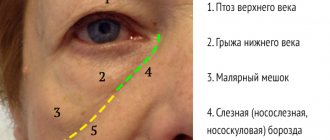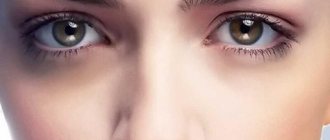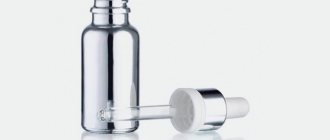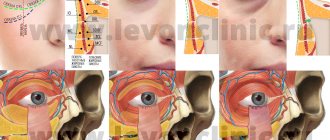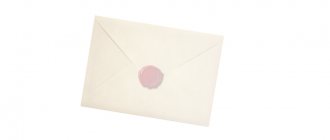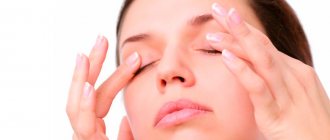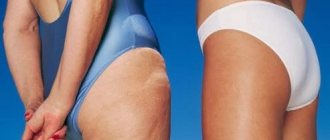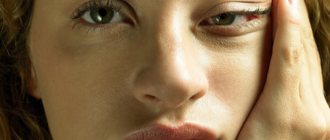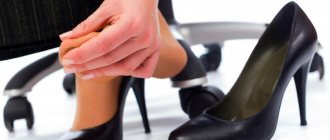Often in the morning a person does not look aesthetically pleasing enough; for example, the eyelids may swell. There is nothing terrible about this, but the appearance suffers considerably, especially if this happened to a representative of the fair sex. At the same time, men often experience discomfort when their eyes are swollen after sleep, since others may joke about the large amount of alcohol they drank or a stormy night. To know how to deal with this problem, you need to understand the main causes of this condition.
How to remove swelling from the eyelids?
Swelling occurs due to the accumulation of a large volume of fluid in the intercellular space. The skin around the eyes is the thinnest.
In this article
- How to remove swelling from the eyelids?
- The most common causes of eyelid swelling
- How to relieve swelling of the eyelids after drinking alcohol?
- Eyelids are swollen after tattooing - what to do?
- How to remove swelling from the upper eyelid using folk remedies?
- How does massage help remove swelling from the upper eyelids?
- How else can you remove swelling from your eyelids?
Because of this, swelling appears on the eyelids or under the eye sockets. Other parts of the body also swell, but on the face it becomes immediately noticeable. Swelling of the eyelid or eye is not only a cosmetic problem. This symptom may signal the development of a disease, not necessarily related to the organs of vision. Let's look at all the possible causes of eyelid swelling and find out how to remove them.
How to get rid of “bags” under the eyes using cosmetology?
It is faster and more expedient to remove pronounced fatty hernias of the lower eyelids if they have been present for a long time, as well as with excess stretched sagging skin and wrinkles (folds). Even several sessions with a cosmetologist may not lead to the desired aesthetic result. However, if puffy or fatty “bags” and “circles” under the eyes have been bothering you not so long ago, as well as the first signs of age-related skin changes (wrinkles, loss of tone), then you can fight them in the cosmetologist’s office. Let's talk about the most effective methods.
Injection cosmetology - MesoEye C71
What problems does it solve?
- Copes with persistent swelling;
- Removes noticeable “bags” (hernias) under the eyes, including eye bags;
- Removes dark circles;
- Removes wrinkles, including crow's feet;
- Noticeably refreshes a “tired look”;
- Effectively fights signs of age-related skin changes.
How many procedures will be required?
On average, 4-6. The result is visible after the first procedure.
Rehabilitation
Depends on skin sensitivity. Injections in the delicate and sensitive periorbital area, of course, cannot be called pleasant, but the micropapular technique allows you to not be a red panda after just 1 day 
Lymphatic drainage massage
What problems does it solve?
- Removes lymph and excess fluid, thus relieving swelling;
- Strengthens the skin around the eyes, enriching it with oxygen and stimulating the production of its own collagen and elastin;
- Smoothes out wrinkles;
- Returns tone to sagging skin.
How many procedures will be required?
A lasting and pronounced effect requires more than 4 procedures. Can be combined with home eye care.
Rehabilitation
No
Home care Follement Professionnel (France)
What problems does it solve?
- Noticeably reduces swelling under the eyes, has a drainage effect;
- Normalizes water balance;
- Prevents skin aging;
- Reduces the number of wrinkles and makes them less pronounced;
- Fights dark circles under the eyes;
- Fights signs of age-related skin changes, improves its tone.
How many procedures will be required?
Products from the Follement Professionnel line are recommended as additional regular skin care at home. Best combined with lymphatic drainage, microcurrent, or if you discuss this problem with a doctor. However, if puffy “bags” and dark circles under the eyes are not very pronounced, then you may be satisfied with the effect without procedures. Cosmetics contain special active ingredients. 78% of women and men note a visible effect after 1 month of use.
Rehabilitation
No
In our clinic you can consult with both a cosmetologist and a plastic surgeon (free of charge and even online). The doctor will select an individual option for facial beauty or an effective home care product with active ingredients. You can also purchase them in our clinic. And don’t forget to look at our website in the “promotions” section.
Microcurrent therapy
What problems does it solve?
- Remove dark circles under the eyes;
- Noticeably tightens the skin around the eyes, increases tone;
- Activate the production of their own collagen and elastin;
- Reduce the volume of subcutaneous fat - hernias at an early stage;
- Remove swelling;
- Returns skin tone.
How many procedures will be required?
The number of procedures is individual, on average 5-6 sessions. Can be combined with additional home care for the skin around the eyes.
Rehabilitation
No
Contour plastic surgery (filling) of the nasolacrimal groove with fillers
What problems does it solve?
- Allows you to fill the nasolacrimal groove and visually smooth the surface of the skin around the eyes;
- Reduce dark circles under the eyes;
- Smooth out small wrinkles;
- They improve skin quality and promote rejuvenation, since the main component is hyaluronic acid.
.
How many procedures will be required?
Depending on the drug and the individual characteristics of the skin, the effect lasts for a period of 6-12 months.
Rehabilitation
Like mesotherapy, it depends on the sensitivity of the skin. For 7 days, you need to protect your skin from heat and ultraviolet radiation, and follow the cosmetologist’s recommendations for the use of decorative cosmetics.
Laser resurfacing Deka SmartXide (non-surgical blepharoplasty)
What problems does it solve?
- Marked rejuvenation of the skin of the periorbital area - the skin of the eyelids tightens, becomes toned and elastic at the cellular level;
- Makes the nasolacrimal groove less pronounced, visually removing “bags” under the eyes (but not fatty hernias);
- Evens out skin texture, smoothes out fine wrinkles;
- Promotes rapid skin regeneration;
- Noticeably refreshes the look.
How many procedures will be required?
Depending on the scale of the problem, approximately 2-4 sessions. However, after the first grinding, the result will pleasantly surprise you.
Rehabilitation
7 days
What causes swelling of the eyelids and what should be done to relieve it?
Swelling may occur in one eye or both. In such cases, they speak of unilateral or bilateral edema, respectively. Most often the upper eyelids swell. This can happen for various reasons - pathological and non-pathological. The first group of factors includes eye diseases and diseases of other organs. Swelling of the eyelids is almost always observed with the development of inflammatory ophthalmopathologies. Among them:
- keratitis;
- blepharitis;
- conjunctivitis;
- iridocyclitis;
- barley.
The eyelids also swell with some systemic ailments - diseases of the kidneys, liver, blood vessels, diabetes mellitus, allergies, abdominal dropsy. Swelling of the upper eyelid is a very common symptom that cannot be called specific. It is difficult to determine from this sign alone whether it is a consequence of any pathology. However, often the eyelids swell for reasons that are not related to disease.
The most common causes of eyelid swelling
Swelling of the eyelids appears due to hormonal imbalances, as a result of visual fatigue, injury, after an insect bite, due to prolonged exposure to ultraviolet radiation on the eyes and skin.
In some cases, swelling occurs briefly after taking certain medications. However, the most common causes of edema are:
- alcohol consumption;
- poor nutrition;
- tattoo;
- overwork.
Let's look at these reasons in more detail and list ways that help quickly remove swelling.
How to relieve swelling of the eyelids after drinking alcohol?
After drinking alcohol-containing drinks in large quantities, not only the eyelids, but also the entire face swells. With chronic alcoholism, swelling occurs in the legs and arms, which already indicates the development of severe pathologies of internal organs. The main cause of edema is the inability of the liver to process ethyl alcohol into components that would be harmless to the body. Also, swelling may indicate poor functioning of the urinary system, which leads to fluid stagnation.
Swelling usually goes away within a day or 24 hours. The speed of recovery depends on several factors:
- amount of alcohol consumed;
- frequency of drinking alcoholic beverages;
- person's age;
- condition of internal organs;
- genetic characteristics;
- body weight.
Edema can also occur in people who rarely drink. It depends on the body. Sometimes a feast cannot be avoided. Many people drink alcohol at corporate events and then have to go to work the next day. In the morning you saw that your face and eyelids were swollen, and you somehow needed to leave the house. What to do in this case? Women who are more concerned about this problem than men can hide puffiness under makeup. In principle, swelling will go away on its own within one or two days. It is only necessary to restore the balance of salts and fluids in the body, as well as get enough sleep.
Swelling of the eyes and face in women in the morning: causes and treatment
The appearance of this type of difficulty occurs due to a disruption in the process of removing fluid from the intercellular space. And they cannot be ignored. Although they may be based on fairly safe factors.
- For example, the problem may arise from sleeping too much. Due to the fact that water is not removed in time, and to reduce the load on the urinary system, liquid begins to linger in the intercellular space.
- Excessive drinking before bedtime leads to edema. During sleep, all systems work slower, and the body does not have time to fully process what has been received.
- Poor nutrition affects the concentration of sodium and proteins in the blood, and causes swelling.
- And chronic lack of sleep leads to a malfunction in the processes of fluid microcirculation. And the places where the skin is most elastic are the first to show the consequences of such a change. Most often in the form of swelling of the eyelids.
- Alcohol abuse not only disrupts the circulation of fluid in the body, but also increases thirst.
- Severely dry air in the room also causes some swelling.
In addition to external ones, there are more important reasons for the appearance of this disorder. For example, during pregnancy, especially in its last trimester, women often suffer from edema. Rarely, but still there are people with a hereditary predisposition to the accumulation of fluid in the tissues.
Osteochondrosis of the cervical spine disrupts blood circulation and causes stagnation of lymph, which also provokes the appearance of this problem. An allergic reaction (including to cosmetics) also leads to swelling. Moreover, the intensity of this process is sometimes such that there is a danger of suffocation. This allergy symptom can either be relieved by taking medications or go away on its own; compresses and other folk remedies are powerless.
Difficulties with microcirculation arise:
- for diseases of the heart and cardiovascular system;
- for renal pathologies;
- in case of oncology;
- due to diabetes mellitus and metabolic disorders;
- when a focus of infection occurs in the maxillofacial area;
- etc.
Therefore, if the problem occurs regularly without any explainable reasons or its manifestation is asymmetrical, consult a doctor. Such violations are a symptom of a dangerous disease.
Eyelids swell in the morning - what is the reason and how to remove the swelling?
If your eyelids are swollen after sleep, most likely the reason for this is poor nutrition. A late dinner consisting of smoked or too salty foods makes you thirsty.
A person drinks one or two extra glasses of water before bed, and wakes up in the morning with a swollen face. Usually there are bags or bruises under the eyes. Some people experience swelling of the upper eyelids. Also causes of swelling can be:
- lack of sleep;
- cosmetics that are not washed off before bed;
- smoking;
- overwork;
- stress;
- cry.
All these factors are not associated with diseases, so you can eliminate swelling yourself at home. You can quickly relieve swelling caused by the above reasons using cosmetic procedures, massage, ice and other means, which we will discuss later.
General recommendations for troubleshooting
The first and main recommendation is to start leading a healthy lifestyle:
- Regular sleep of 8–10 hours.
- Balanced diet with reduced amount of salts. Reduce consumption of carbonated drinks, coffee, fatty, smoked and fried foods.
- Introduce natural diuretic foods into your diet: citrus fruits, carrots, watermelons, apples, melons, etc.
- Quit smoking and alcohol abuse.
- Drink diuretic teas, fruit drinks and infusions from: lingonberries and their leaves, cranberries, blackberries, viburnum, rowan.
- If swelling appears after sleep, change the pillow to a higher and more elastic one.
And, of course, just in case, you should consult a doctor about the causes of this problem. Because in this case, self-medication can only be done when you know that the disorder is not caused by a serious illness.
For example, swelling of the cheeks often appears as a result of injury, diseases of the teeth and oral cavity, allergies, inflammation of the lymph nodes and other diseases.
Only special medications should be used against allergies; other methods will not help. And swelling associated with inflammation of the facial nerve should not be treated with various cold compresses, as they will only worsen the situation. Therefore, if your cheeks for no apparent reason begin to look somehow wrong, you should contact the clinic.
You can reduce the likelihood of swelling after sleep with the help of diuretics:
- Natural. We have partially listed foods and drinks with this effect above.
- Medical. These include Torasemide, Amiloride and others. You can also try to relieve swelling with Leoton gel, which is primarily used for the legs. Since the gel is not intended for the face, it must be used with great caution, avoiding contact with the eyes.
The use of medications and diuretics should be agreed with doctors. Here are a few more recipes to improve fluid circulation in tissues:
- Diuretic based on blackberries. You need 80 grams of blackberry leaves, and 10 grams of coltsfoot leaves and birch leaves. The ingredients are mixed and poured with boiling water (1:2). Then keep in a water bath for 15 minutes. The resulting infusion is filtered. The decoction should be drunk in the morning and afternoon, one glass at a time. Usually the course takes up to one and a half to two weeks.
- An infusion of bear's ear herb has an antiseptic effect on the urinary system, so it will be especially useful for kidney diseases. Here you need 1 tbsp. collection spoon. It is poured with a glass of hot water and left in a thermos for 2 hours. The resulting infusion is filtered. You need to take the product 2 times a day, half a glass.
- Flax-seed. It helps remove excess fluid well. For the effect, you need to eat 1 teaspoon of ground seeds daily. They can also be added to porridges and other dishes, since they do not have a pronounced or unpleasant taste and smell. Duration of treatment – 1 month.
Eyelids are swollen after tattooing - what to do?
Tattooing is a cosmetic procedure that is very popular today. It is performed in beauty salons only by qualified specialists. Usually, materials that are safe for health are used, so tattooing does not cause side effects. However, no one is safe from them either.
The causes of eyelid swelling after tattooing can be:
- failure to comply with the cosmetologist’s instructions after the procedure;
- use of low quality pigment;
- too dry or thin skin;
- allergic reaction to dye;
- infection under the skin.
Eyelid or eyebrow tattooing is performed using a cosmetic instrument that comes into contact with the skin. Dye is injected underneath it. In this case, the integrity of the skin is compromised. As already noted, facial skin is very thin and sensitive. Any irritating factor can cause swelling under the eyes or on the eyelids. There is a risk of developing an inflammatory process, which is, of course, rare if the procedure is performed in a good salon.
Tissues react to the pigment as if it were a foreign body. Slight swelling is normal after insertion. Also, some patients complain of pain, itching, redness of the eyelids or eyebrows. However, there should not be severe swelling. Temporary swelling subsides during the first 24 hours after the procedure. If this does not happen, you need to consult a doctor.
How to remove swelling in such cases? It is not recommended to eliminate the symptom yourself until a specialist determines the cause of its occurrence.
How to remove swelling of the eyelids?
Swelling from the eyelid can be eliminated at home, in a clinic or in a salon. It all depends on what is causing the symptom, whether you have the time and money or not. If the nature of the swelling is pathological, then you first need to see a doctor. Typically, swelling of the eyelids as a symptom of the development of an eye disease is accompanied by the following signs:
- hyperemia or pallor;
- transillumination of blood vessels;
- lacrimation;
- itching and burning;
- thickening of the cartilage of the eyelid;
- pain;
- discharge of mucus or pus.
If you have several of these symptoms, you should see an ophthalmologist. It is dangerous to relieve swelling from the eyelid using folk remedies or medicines that are in your home medicine cabinet. The disease may become more complicated. If you are sure that swelling of the eyelid is not a consequence of the development of the disease, you can use the recipes of the so-called traditional medicine. Let's find out what you can urgently do to get rid of puffiness.
Cosmetics to eliminate swelling
To effectively eliminate puffiness, it is recommended to use those cosmetics for the skin around the eyes that contain caffeine, which improves blood circulation in the tissues. Additional hydration can be achieved by adding vitamin E, essential oils, grape seed extracts, parsley, and rice bran to the product.
Cosmetic patches soaked in moisturizing and toning ingredients - aloe juice, glycerin - will help you get rid of swelling of the eyelids in a short time. Upon contact with the skin, all substances penetrate the skin, tighten it, improve lymph flow and blood circulation. Apply cosmetic patches every day at night or in the morning.
How to remove swelling from the upper eyelid using folk remedies?
You can quickly get rid of swelling of the eyelids with the help of lotions, compresses and face masks. They do not cure diseases, but help soothe the skin and muscles, which promotes the outflow of excess fluid. On the Internet you can find many recipes that are used to relieve swelling of the eyelids. Let's list some of them:
- Cold. Everyone has ice cubes in their refrigerator. They need to be wrapped in gauze or bandage and applied to closed eyelids for 1-2 minutes. The eyes should not be too cold. It is better to apply ice to the eyelids intermittently.
- Carrot. Make a mask from the grated vegetable. You can apply it not only to the upper eyelids, but also to the skin under the eyes, the bridge of the nose, and cheekbones.
- Flax seeds. They need to be filled with hot water and left overnight. The resulting broth is filtered. Lotions are made from it and applied to the eyelids for 10-15 minutes. This remedy is believed to help with swelling and inflammation. However, if there is an inflammatory process, it should be treated by a doctor.
- Tea with mint. Tea may have a decongestant effect. Tea compresses are applied to the eyes for 15-20 minutes. Instead of tea leaves, you can also use plants such as chamomile, calendula, thyme, fireweed, and sage.
- Chilled milk. Tampons are moistened in it and left on the upper eyelids for 20-25 minutes. Also, some supporters of traditional medicine suggest using other dairy products - cottage cheese or sour cream.
- Raw potatoes. It can be cut into circles or grated on a fine grater to make compresses.
- Egg white. It has an astringent effect. Apply to eyelids for 15-20 minutes, then wash off with warm water. Daily use of eggs in this way helps smooth out wrinkles on the eyelids.
These products help to slightly eliminate swelling. There are more effective methods. Let's find out how to remove swelling from the upper eyelids using massage.
Types of skin diseases around the eyes and eyelids
Among the huge number of diseases caused by inflammation of the eyelids, several of the most common groups can be distinguished:
- bacterial lesions of the skin of the eyelids (abscess of the eyelid, phlegmon);
- inflammatory diseases of the glands and edges of the eyelids (blepharitis, barley, chalazion, meibomitis, demodicosis);
- violations of the shape and position of the eyelids (entropion, eversion, ptosis, lagophthalmos);
- allergic diseases (eczema, dermatitis, angioedema);
- developmental abnormalities of the eyelids and tumors (coloboma, papilloma, lipoma, nevus).
Bacterial lesions of the skin of the eyelids
Abscess of the century
An abscess is inflammation and redness of the eyelid with the formation of a cavity filled with pus. Often an abscess appears after an infected eyelid wound.
Causes of eyelid abscess:
- ulcerative blepharitis;
- boils;
- barley;
- purulent processes in the paranasal sinuses and orbit of the eye.
Sometimes the abscess opens on its own, and the inflammation subsides. But in most cases, a non-healing fistula appears at the site of inflammation.
Treatment of an abscess is sanitation of the eyelids and opening of a purulent formation on the eyelids with the mandatory use of antibiotics and sulfonamides.
Phlegmon
Cellulitis is an extensive inflammation of the tissues of the eyelid that occurs against the background of untreated stye. It is characterized by fever, headache, severe swelling of the eyelid and redness of the skin.
Treated with antibacterial agents, antihistamines.
Inflammatory diseases of the glands and edges of the eyelids
Blepharitis
Blepharitis is an inflammation of the eyelids, which causes redness, burning, itching and pain on the skin.
The following types of blepharitis are distinguished: allergic, meibomian, demodectic, infectious, scaly. Read more about blepharitis here.
Barley
Barley is an acute, infectious inflammation of the eyelids, resulting from pathogens entering the eyelash hair follicle or the sebaceous gland of the eyelid. Visually, stye looks like a small nodule on the eyelid.
You can read about how to properly treat stye on this page.
Meibomyitis and chalazion
Meibomyitis and chalazion are diseases associated with the appearance of a pathological process in the meibomian glands.
Meibomia appears when the duct of the sebaceous gland of the eyelid is clogged. Characterized by an acute course of the disease.
Chalazion is a chronic form of meibomitis. If a chalazion is left untreated for a long time, it turns into an eyelid cyst. Sometimes, for diagnostic purposes, it is necessary to puncture the eyelid cyst to identify the nature of the neoplasm.
Treatment and removal of a cyst on the eyelid occurs using classical techniques or laser treatment.
For more information about the symptoms and treatment of this pathology, see here.
Demodicosis
A disease of the eyelids caused by the Demodex mite. It is characterized by the appearance of yellow mucus in the eyes, gluing and breaking of eyelashes, itching and burning of the eyes.
To cleanse the eye from foci of infection, cleaning (sanitation) and rinsing of the lacrimal ducts are used. Read about the treatment of demodicosis on this page.
1 Diseases of the skin around the eyes and eyelids. Diagnosis and treatment
2 Diseases of the skin around the eyes and eyelids. Diagnosis and treatment
3 Diseases of the skin around the eyes and eyelids. Diagnosis and treatment
Violations of the shape and position of the eyelids
Turn of the century
When the eyelid is inverted, its main edge is turned onto the eyeball. Because of this, the eyelashes touch the surface of the cornea and conjunctiva, the eyes become red, irritated, and tears constantly flow from them.
Causes of pathology:
- convulsive or spastic contractions of some parts of the orbicularis oculi muscle;
- cicatricial contractions of the conjunctiva and cartilage of the eyelid that occur in certain chronic eye diseases (for example, trachoma).
The most effective method of treatment is surgery. Plastic surgery for entropion of the eyelid is also possible.
Eversion of the century
Ectropion is an inversion of the edge of the eyelid. With this inflammation of the eyelid, the conjunctiva turns out in a certain area or throughout the entire eyelid, which leads to its drying out.
The fact that the eye is constantly open, even at night, contributes to clouding of the cornea, the appearance of keratitis and other diseases.
Causes of eversion of the eyelid:
- age-related changes in the eye with sagging of the lower eyelid;
- paralysis of the orbicularis oculi muscle;
- tightening of the skin of the eyelids due to injuries, burns (cicatricial eversion), systemic diseases of the body.
First, it is necessary to eliminate the main causes that caused this disease. Surgical procedures can then be used.
Ptosis
Ptosis is an abnormally low position of the upper eyelids in relation to the eyeballs. This leads to vision defects and rapid eye fatigue. Ptosis can be congenital or acquired.
Causes of ptosis:
- damage to the oculomotor nerve;
- damage to the muscle that elevates the upper eyelid;
- strokes, encephalitis and other neurological diseases.
Treatment of the disease is mainly surgical.
Lagophthalmos
Lagophthalmos is incomplete closure of the palpebral fissure, which leads to damage and drying of the cornea and conjunctiva.
Causes of the disease:
- eyelid injuries,
- jades,
- short eyelids from birth.
In addition to treating the underlying disease, artificial tears and disinfectant drops are prescribed. In severe forms of the disease, surgical intervention with partial suturing of the palpebral fissure is used.
Allergic inflammation of the eyelids
Allergic diseases of the eyelids are accompanied by severe itching, swelling and inflammation of the eyelids.
In eczema , the skin of the eyelids is covered with papules, vesicles and pustules. Characteristic rashes appear not only on the skin of the eyelids, but also on the body. The pathology develops after suffering eyelid dermatitis or contact with allergens. At the end of the disease, crusts and serous exudate appear on the skin of the eyelids.
Characteristic signs of urticaria are swelling of the eyelids, itching and burning of the skin of the eyelids. Subsequently, blisters appear on it.
With contact dermatitis , 6 hours after contact with the allergen, swelling and inflammation of the eyelids develop with itchy papules and vesicles. Usually both eyes are affected at once.
Treatment of allergic inflammation of the eyelids is medicinal.
1 Diseases of the skin around the eyes and eyelids. Diagnosis and treatment
2 Diseases of the skin around the eyes and eyelids. Diagnosis and treatment
3 Diseases of the skin around the eyes and eyelids. Diagnosis and treatment
Anomalies of eyelid development and tumors
Coloboma
Coloboma of the eye is one of the most unpleasant diseases, which is expressed in the absence of some eye membranes. Coloboma of the eyelid is the most common. The pathology appears on the upper eyelids, but sometimes affects the lower eyelids too.
Coloboma is usually triangular in shape, where the base of the triangle is the ciliary edge of the eyelids. Since the defect affects all layers of the organ of vision, there are no eyelashes and glands in the area of coloboma.
In most cases, it is congenital, but can also occur as a result of injury and other illnesses. Another type of congenital coloboma, iris coloboma, is one of the main causes of vision loss in childhood.
Coloboma is a serious danger to the eye, as it leads to degeneration of the cornea, keratitis and other secondary diseases of the organs of vision, as well as blindness!
The most effective treatment for coloboma is surgery. Surgery for coloboma involves excision of damaged tissue and movement of a musculocutaneous flap to the site of the defect. With the help of plastic surgery, the correct edge of the eyelids is formed, which prevents the appearance of ptosis, entropion, and other complications.
Benign formations of the century
Papilloma of the eyelids
Papilloma appears on the lower eyelid usually in people over 60 years of age.
It grows slowly, looks like gray-yellow papillae, and has a spherical or cylindrical shape. In 1 case out of 100, papilloma can turn into cancer. Treatment of eyelid papilloma is surgical.
Senile wart
A senile wart is a flat and even formation of brown, yellow or gray color. It grows in older people along the lower ciliary edge of the eyelids. Treatment: cryodestruction or laser removal.
Cutaneous horn
The cutaneous horn is a dirty gray formation protruding above the eyelid. Electro- and laser excision are used for treatment.
Nevi
Nevus (or mole ) is a benign formation on the skin, from light brown to black. Nevi on the eyelid can be inherited, appear due to long exposure to the sun, disruptions in the hormonal system, or after taking certain medications. Hanging moles can appear in old age. If the formation does not bother you, there is no need to treat it.
If unpleasant symptoms appear: itching, pain, growth, blurred vision, you must consult an ophthalmologist to investigate the nature of the mole and receive the necessary treatment.
Atheroma
Eyelid atheroma ( epidermal cyst ) is a painless, dense formation that appears on the eyelid due to blockage of the sebaceous gland ducts.
Over time, the atheroma begins to increase in size and can impair vision. In this case, surgical procedures are performed. After removal of atheroma of the eyelid, there are usually no complications.
How does massage help remove swelling from the upper eyelids?
If your upper eyelids are swollen after sleep or due to alcohol consumption, you can do a lymphatic drainage massage.
Similar services are provided in salons. The massage is performed with hands or a special device. Massaging the eyelids helps improve blood circulation and fluid outflow. After just one session, which lasts 15-20 minutes, the swelling noticeably subsides. Not everyone has the opportunity to visit expensive salons. If you urgently need a massage to quickly relieve swelling from the upper eyelids, perform it according to the following algorithm:
- wash your hands and face with soap;
- apply moisturizer or oil to the skin;
- Using your middle and index fingers, massage your upper eyelids in a circular motion from the outer corner of your eyes to the inner corner;
- apply a few light pressures to the eyeballs and pat the skin around them with your hands;
- Massage your eyelids, temples, and eyebrows in a circular motion.
The massage should be completed with a contrast wash. If you do it daily, swelling will rarely appear. However, it is necessary to consult a doctor before performing this procedure, as there are contraindications to it:
- eye injuries;
- postoperative period;
- chronic ophthalmopathologies;
- inflammatory diseases of the eyelids and eyes;
- cataract;
- glaucoma;
- retinal detachment.
Do not forget that swelling of the eyelids as a symptom of any illness can only be treated under the guidance of a doctor, so as not to aggravate the situation. You can resort to folk remedies and massage only if it is approved by a specialist, and swelling rarely occurs and is not due to disease.
Eye swelling due to allergies, what to do
In order to quickly relieve allergic swelling, it is necessary, first of all, to eliminate the effect of the factor that caused such a reaction (cosmetics, food, dust, animal hair, midge bite), and rinse the eyes with plenty of running water.
Then take an antiallergic drug or apply directly to the area of swelling. As a rule, antihistamines are used: Suprastin, Cetrin.
Cold compresses made from a piece of ice or frozen chamomile decoction have a good effect. You can also wipe the eyelid with a solution of novocaine or anesthesin. The area where the swelling has formed can be anointed with Prednisolone or Celestoderm.
Will eye exercises help remove swelling?
Special exercises to relax the eye muscles will help relieve swelling if it is not caused by illness. Eye exercises increase blood circulation and oxygen supply to tissues. This also helps eliminate swelling, although not as effective as lymphatic drainage massage. If desired, you can use several treatment methods at the same time.
Try the following exercises:
- move your eyeballs in different directions;
- close your eyes tightly and open your eyes wide, repeating this algorithm 5 times;
- massage the upper eyelids with your fingers from the bridge of the nose to the outer corner of the eyes and back;
- pull the lower eyelid up and relax, then repeat this with the second eyelid.
You can use other sets of exercises. It is better for your doctor to choose it for you, especially if you have vision problems. Gymnastics may be contraindicated in case of refractive errors, for which special exercises are selected. You should also not do exercises if you have inflammatory eye diseases, retinal pathologies, increased intraocular pressure and some other diseases.
Massage treatments
Massage will help remove swelling. Using light movements, lightly pressing on the skin, massage the eyelids with your fingertips for several minutes. The skin in this area is very thin, delicate and requires careful handling.
To achieve the best effect, you must use natural oils: grape seed, almond, peach or moisturizer. After the massage procedure, you should briefly apply cotton pads soaked in cold water.
In addition, it is recommended to perform some exercises:
- Squeezing your eyes shut. You need to close your eyes tightly for 5-7 seconds, then open your eyes wide. The exercise should be repeated 10-12 times.
- Circular rotation of the eyeballs. It is necessary to perform several rotations clockwise, then counterclockwise. At the same time, you should keep your head straight.
- Blinking. You should blink quickly and relax your eye muscles for 10-12 seconds.
- Complete the set of exercises with palming.
How else can you remove swelling from your eyelids?
For swelling, physiotherapeutic procedures may be prescribed. Some of them are available only in paid clinics. This method of treatment is the most effective of those listed. In several sessions of physiotherapy, it is possible not only to relieve swelling, but also to smooth out wrinkles, increase skin and muscle tone, and improve blood circulation in the eye area. The following procedures are applied:
- myostimulation;
- electrical stimulation;
- fractional thermolysis;
- cryotherapy.
There are contraindications to this treatment, so you will have to undergo an examination before the procedures.
How to prevent swelling
Naturally, you can get rid of this problem just by regularly leading a healthy lifestyle. If you are actively involved in sports, monitor the quality of your diet, do not indulge in alcohol, and do not allow stress to become the master of your life, then not only your eyes, but your entire body will thank you.
You will always look young and fresh, catching the admiring glances of others. If you follow these simple rules, a contrasting wash in the morning will be enough for you to look irresistible.
What happens if swelling is not treated?
Some people's eyelids always seem swollen, which is due to their structure or some congenital defect. In most cases, swelling goes away on its own without treatment. If swelling on the face is a frequent symptom that worries you, you need to make an appointment with an ophthalmologist. Pathological edema can, if left untreated, lead to the development of complications, including glaucoma. Also, constant swelling of the eyelids, if they block the pupil, can affect vision.
Prevention of edema includes the following rules:
- balanced diet, consumption of a small amount of salt and volume of water corresponding to body weight;
- rejection of bad habits;
- normal mode of work, rest and sleep;
- timely treatment of all diseases.
Swelling of the eyelids seems to be a harmless symptom, but if it occurs, it is better not to take risks and not to self-medicate, but to visit a doctor.
Treatment of eyelid edema using traditional medicine
Therapy for edema is aimed at identifying the causes of this condition. Since swelling is usually an accompanying symptom, it is very important to establish the root cause of its occurrence. If the formation of edema is associated with an inflammatory process that was caused by an infection, the ophthalmologist will prescribe antibacterial or antiviral drugs. These can be eye drops and ointments. For inflammatory swelling of the eyelid, doctors often prescribe physiotherapy. Mesotherapy or blepharoplasty can be performed. These are cosmetic procedures that allow you to tighten the skin of the eyelid.
If eye swelling is not due to inflammation, then doctors prescribe treatment only after the nature of the disorder is identified. If the formation of swelling is caused by improper sleep patterns or lack of nutrients due to diet, then applying a cold compress, taking diuretics or lymphatic drainage massage will help relieve the swelling. The cause of swelling of the eyelids is sometimes associated with fatty hernias. In such cases, doctors prescribe surgical treatment. Removing excess areas of fatty tissue allows you to get rid of swelling.
When allergic edema forms, treatment is not prescribed so often. In most cases, it goes away on its own. If the swelling is severe, the patient is prescribed antihistamines. For severe forms of allergies that are accompanied by other diseases, steroid medications may be recommended. It is very important to establish what caused the swelling of the eyes and to identify the allergen through testing. Limiting contact with it allows you to quickly relieve swelling and speed up the healing process. It also helps prevent relapses of inflammation in the future.
It is possible to relieve swelling of the eyelids, which is the result of injury, damage to the soft tissues around the eyes, by eliminating the traumatic lesion. If there is no open wound, then cold compresses are allowed to be applied to the damaged areas of the skin. The subsequent stages of treatment consist of local treatment of the swelling. For this, ophthalmologists prescribe anti-inflammatory drugs. If tests show that an injury caused bacteria to enter the body, then doctors will additionally recommend antibacterial medications. They help prevent infection of the damaged skin area.
Medical treatment includes the use of eye drops and ointments. The doctor selects them in accordance with the cause of eyelid swelling. The most common and effective drugs that are usually used to relieve swelling are:
- "Tobrex";
- "Indocollier";
- "Prednisolone";
- "Hydrocortisone";
- "Allergodil";
- "Opatanol";
- "Visine."
Before prescribing medications, the ophthalmologist carefully examines the patient’s medical history and inquires about the presence of chronic diseases. Sometimes consultation with a specialist is required, for example, a nephrologist, cardiologist, allergist and others. You should not start treatment on your own.
